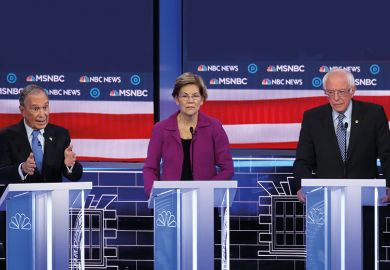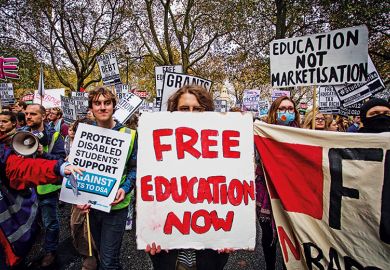US advocates of free university education are seeing months of excitement over Democratic Party unanimity on the effort tempered by concern that low turnout among young voters might yet hobble the odds of robust implementation.
Former vice-president Joe Biden scored a clear victory in the Democrats’ 14 Super Tuesday state primary elections, with Senator Bernie Sanders close behind. All other candidates are well back in the race to challenge Donald Trump in November’s general election, most having now quit.
Both the two leading Democratic rivals are offering extensive plans for reducing the cost of higher education – Mr Biden has suggested two years of free college and student loan forgiveness after 20 years, while Mr Sanders would make all public institutions fee-free and cancel all existing student debt.
Nevertheless, with the exception of California, the turnout among young voters appears to have been down across the board in all the big Super Tuesday states – including Texas, North Carolina, Virginia, Massachusetts and Tennessee – compared with the 2016 contests.
That directly hurt Mr Sanders, who was leading the Democratic race before Super Tuesday. Polling had shown that he enjoyed the greatest support among younger Americans, and he was pushing the most aggressive free-college plan.
Some analysts have said that the persistently low participation of young voters could mean another four years of a president with little focus on student debt burdens, or the elevation of a Democrat lacking Mr Sanders’ enthusiasm for the idea.
“The one group who seem to be most vehement about this singular issue are young voters,” said Patrick Murray, director of the Monmouth University Polling Institute. “Unfortunately for Sanders, they simply haven’t been showing up in very large numbers.”
But those pressing for lower university costs still have reasons to retain some optimism, say experts, who point out that free-college programmes are already expanding at the state level across the US, that Mr Biden has a record of support for them, and that young voters are more likely to show up for the general election.
“The general election is the real test,” said Raphael Sonenshein, executive director of the Pat Brown Institute for Public Affairs at California State University, Los Angeles. “And I don’t think young voters are the only constituency on this issue,” Professor Sonenshein said of efforts to cut higher education costs.
After initial primary contests in four relatively small states, the Super Tuesday voting accounted for more than 1,300 Democratic convention delegates, or about a third of all those ultimately available. Mr Biden finished first in 10 of the 14 states and collected nearly half the day’s delegates, with Mr Sanders taking most of the rest.
The next closest, Elizabeth Warren, a senator and former Harvard University professor, had about one-tenth as many delegates as the two leaders and has now dropped out. Close behind her was the billionaire Michael Bloomberg, who promptly quit the race and joined several other failed candidates in endorsing Mr Biden, reflecting a widespread fear among the Democratic establishment that Mr Sanders and his “democratic socialist” branding would fare poorly against Mr Trump.
Such labels aside, every major Democratic candidate this year endorsed the idea of at least two years of free college. That is a “pretty striking” shift from just a few years ago, said Mark Huelsman, the associate director of policy and research at Demos, a left-leaning thinktank.
Mr Sanders and Ms Warren went beyond that by calling for four years of government-financed higher education. Mr Sanders also has proposed forgiving all existing student debt, while Mr Biden has suggested reducing loan payments via a formula tied to income, ending with full forgiveness after 20 years.
Altogether, the Sanders plan is three times costlier than that of Mr Biden. But Mr Biden, whose wife is a community college English lecturer, is seen as more likely to criticise Mr Sanders on his overall ambitions for expanding government spending than to fault his higher education plans.
In competing for the relatively few younger voters who did participate on Super Tuesday, Mr Sanders far outperformed Mr Biden, beating him by better than a three-to-one margin among those aged 29 or younger.
But either candidate, said David McCuan, a professor of political science at Sonoma State University, would need to expand youth turnout to beat Mr Trump in the general election.
In that respect, the Super Tuesday numbers clearly showed Mr Biden sitting further behind, Professor McCuan said. But Mr Bloomberg could be an important wildcard. While the former New York mayor endorsed Mr Biden for the rest of the primary season, he has promised to use his immense wealth to help the eventual nominee throughout the year.
That might prove useful in an environment where both major parties are again expected to press the high-tech and high-dollar boundaries of how social media tools can be used to win voters’ support, Professor McCuan said.
Mr Trump’s strong preference for negative politics could mean a year where young voters disproportionately avoid the party primaries but then show up for the general election in November, Professor McCuan said.
“They’re worried – but they’re not worried enough to do two steps,” he said of college-age voters. “They’re worried enough to do one step.”
POSTSCRIPT:
Print headline: Poll pall casts doubt on free-college push
Register to continue
Why register?
- Registration is free and only takes a moment
- Once registered, you can read 3 articles a month
- Sign up for our newsletter
Subscribe
Or subscribe for unlimited access to:
- Unlimited access to news, views, insights & reviews
- Digital editions
- Digital access to THE’s university and college rankings analysis
Already registered or a current subscriber?








